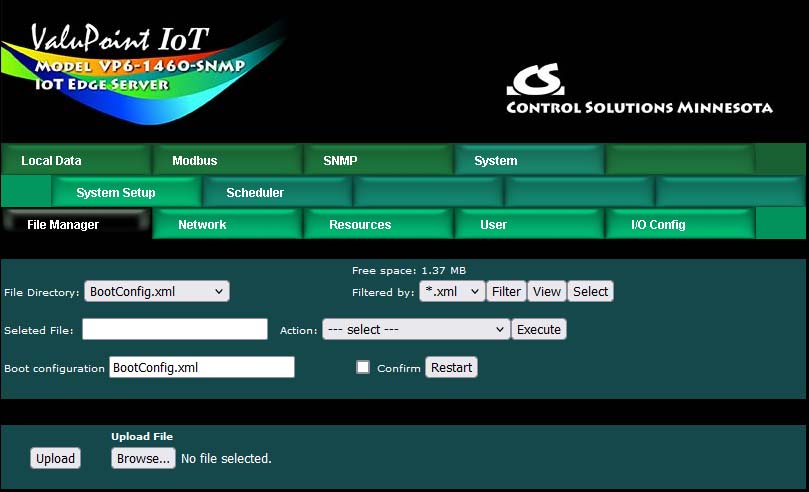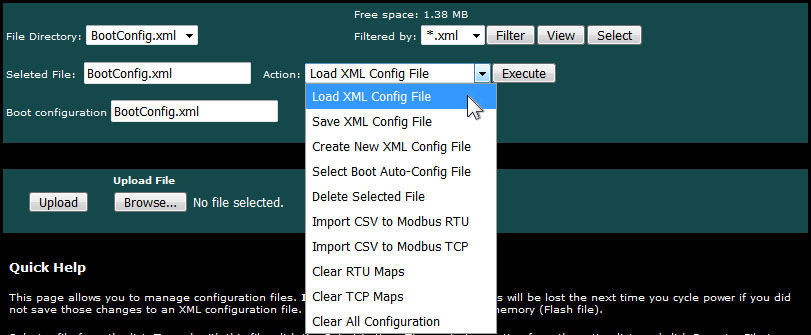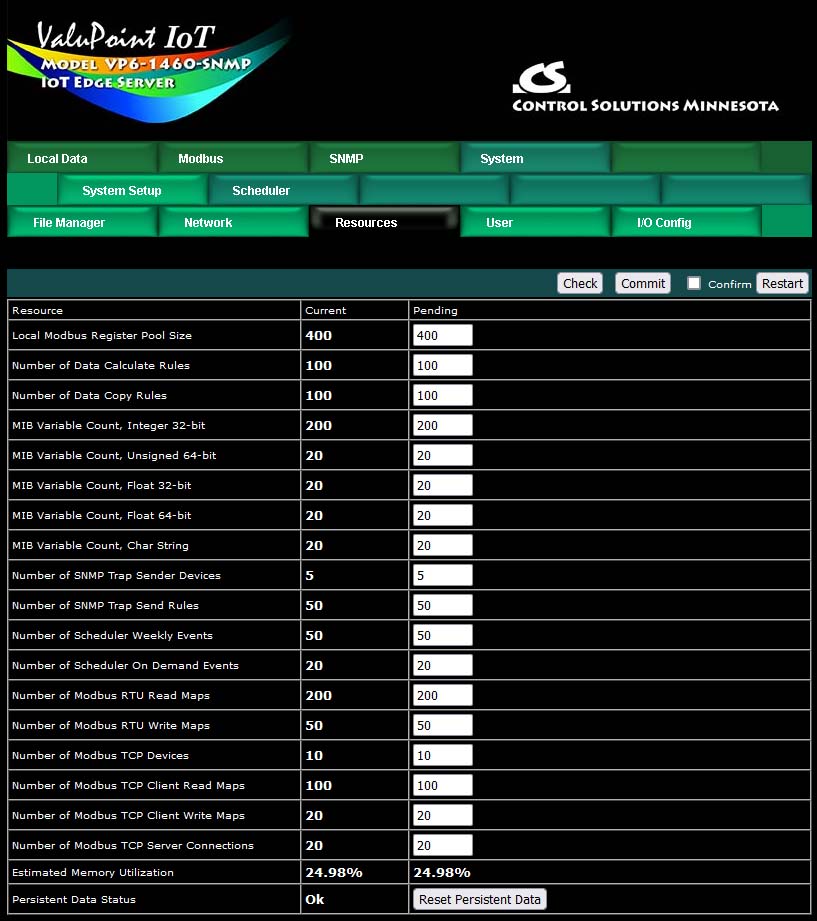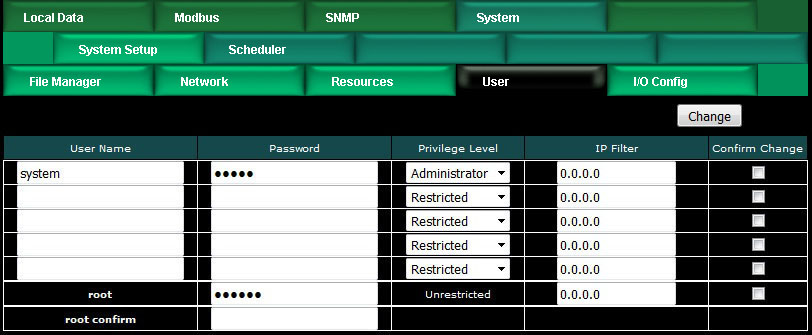
 |
The File Manager page is probably one of the most important pages to know about. Among other things, this is where you tell the ValuPoint to save all of the changes you have made. The various "Update" buttons on the many pages in the web user interface only copy your configuration from your PC's browser to temporary memory in the ValuPoint. To retain those changes indefinitely (i.e. through restart or power cycle), you need to tell the ValuPoint to save those changes in a configuration file.
The configuration files are stored in non-volatile (Flash) memory. The process of reprogramming the Flash takes a little time. It would be cumbersome to rewrite that file every time you made a minor change. Therefore, in the interest of being more responsive, and in the interest of extending the life of the Flash, configuration is only saved to Flash when you direct it to do so.
The File Manager is used in several other ways in addition to managing your XML configuration files. You upload SSL certificates here. You import CSV files for Modbus configuration here.

The File Directory is a list of files that are currently stored in the ValuPoint's Flash file system. To filter files by type, select a type from the Filtered by list, and click Filter.

File type filters are as follows:
| *.xml | XML configuration files | |
| *.sb | Script Basic programs (not available with SNMP) | |
| *.pem | SSL certificates (for HTTPS) | |
| *.csv | CSV spreadsheet for Modbus register import | |
| *.txt | Text file (not used with SNMP) | |
| *.* | Display all files |
There are several file related actions you may take. To take action with a certain file, select that file from the File Directory list, and click Select. That file should now show up in the Selected File window.
Once a file has been selected, choose your action from the Action list, and click Execute.

You must use the Select button to populate the Selected File window prior to executing any action from the list. Choose a file from the drop down list that shows all available files, then click the Select button. You may then act on that file.
You do not need to use the Select button to simply View a file. Clicking View will cause your browser to display the file chosen from the drop down list. If you attempt to View a CSV file, your PC will likely ask if you want to download the file or open it with your spread sheet program (e.g. Excel).
Upload File: To upload a file from your PC to this ValuPoint, use the Browse button to find the file on your PC, open the file in the PC's file dialog box, and then click Upload.
NOTE: If you get a message about directory needing synchronizing, click the browser's "back" button again to return to this page and click Upload again. This gets the browser and HTTP server back in sync, and this requirement generally happens only once or twice following power-up.
Restart: To restart the ValuPoint, check Confirm and click Restart. This is a hard reset that will accomplish the same thing as a power cycle without physically disconnecting and reconnecting power.
Load XML Config File: The configuration file shown in the "Boot configuration" window will be loaded automatically at startup. If you have uploaded a new configuration file and wish to use it without restarting, select that file and select this action.
HINT: If you are loading a file generated externally and you get "parameter out of range" errors pertaining to defining registers or "table full" errors while loading maps or rules, you might not have sufficient resources allocated. You may need to increase some counts on the Resources page.
Save XML Config File: Any time you have made configuration changes that you want to retain as permanent, you need to come here, select the file from the directory list, and execute this Save action.
Create New XML Config File: You have the option to a totally new configuration file. This is often suitable if you started with an existing configuration, made changes, and want to save your changes without replacing the original configuration. To create a new file, rather than selecting a file from the directory list, simply type a new name into the Selected file window. The name cannot contain spaces or special characters, and be sure to use the correct file suffix. Enter the name and execute this action.
Select Boot Auto-Config File: This is where you tell the ValuPoint what configuration to automatically load upon startup. To set the Boot configuration, select the XML file from the list, and execute this action. The name of the startup file, along with a few other important things like the ValuPoint's own IP address, are stored in a different area of Flash that is not part of the file system.
When selecting a new Boot configuration file, it is a good idea to select the file, and execute Load XML Config File. If there are errors, they will be displayed. If there are errors in the file but you do not fix them, then the ValuPoint will not fully start up the next time it restarts. The web user interface will be available, but it will not be talking to Modbus devices.
Delete Selected File: Remove a file from the Flash file system by selecting it and executing this action.
Import CSV to Modbus RTU: You can configure Modbus RTU read and write maps in bulk by importing the maps as a CSV file that you created using a standard spreadsheet program. Refer to Appendix B for details about the CSV format. Note that maps will be added to the existing map list. If you want to replace existing maps with imported maps, execute Clear RTU Maps first.
Import CSV to Modbus TCP: You can configure Modbus TCP read and write maps in bulk by importing the maps as a CSV file that you created using a standard spreadsheet program. Refer to Appendix B for details about the CSV format. Note that maps will be added to the existing map list. If you want to replace existing maps with imported maps, execute Clear TCP Maps first.
HINT: If you get "table full" errors while importing CSV files, you might not have sufficient resources allocated. You may need to increase some counts on the Resources page.
Clear RTU Maps: Execute this action to clear (completely remove) all Modbus RTU read and write maps.
Clear TCP Maps: Execute this action to clear (completely remove) all Modbus TCP read and write maps. The Modbus TCP device table will be left intact.
Clear All Configuration: Execute this action to completely wipe out all configuration. This includes all Modbus maps and devices, all IoT configuration, and all local registers. This will put you back to a "reset to factory" condition with the exception that your IP address is left unchanged. (See Appendix A, Section A.6, regarding forced hard configuration reset that includes IP address and root password.) If you want to make the now empty configuration permanent, select the file that is also selected as Boot configuration, and execute the Save XML Config File action.
The other means of completely wiping out all saved configuration is to simply delete the file named as the Boot configuration file, and then restart or power cycle the ValuPoint. Upon restart, a new empty configuration file will be created automatically.
There is a means of restoring the ValuPoint to "manufacturer's default settings". First of all, make sure that the Boot configuration file is set to "BootConfig.xml". Then, after selecting this file as the boot file, delete it. Now restart the ValuPoint. Upon restart, and upon finding that the boot configuration name is BootConfig.xml, and it does not exist, the ValuPoint will automatically create one with default parameters. The automatic creation of a default file will not occur with any other file name.
Manual Editing: It is possible to manually edit the XML file outside of the ValuPoint. However, doing so is very prone to errors. If there are errors in the XML file, it will not load successfully on startup. If the configuration does not load on startup, none of the scanners will begin scanning. Because they are all blocked by configuration failure, entering new configuration via the web pages will not result in functionality being restored. You must successfully load a configuration file before the ValuPoint will become functional. To check for errors, select the file here, select Load XML Config File, and click Execute. Error messages that would have been discarded by the automatic loading at startup will now be displayed on an error page if there are any.
Backup Copy of XML Config File: To save a copy of the configuration to your PC, select the file and click the View button. Your browser will now display the XML file. DO NOT do a text copy/paste to try to create an XML file - doing so will result in an invalid file format that cannot be loaded again. You must use the browser's "save as" or "save page" function. The browser should default to wanting to save a file with a .xml suffix. If correctly saved on your PC, you should be able to double click on the saved file and it will result in opening the file automatically in your browser. It was saved correctly if the browser does not give any error messages when displaying the XML (which should now look exactly as it did when you first clicked the View button). Saving the configuration file to your PC, and then uploading on a different device, is a quick and easy way to configure two ValuPoints the same way.
Note about caching: Your browser may cache files. If you view a file, make configuration changes, save the file, then view the file again, you may see the old file cached by the browser. To see the updated file, go to "Options" in your browser's tools menu, and delete temporary Internet files (or delete cache files). Also, if you upload a file, make changes on your PC, and re-upload the same file, the browser may send the old file. Again, you will need to find the button inside your browser options that lets you delete the cached files from your PC. To upload a configuration file from your PC to the ValuPoint, use the Browse button to find the file on your PC, open the file in the PC's file dialog box, and then click Upload.
The Network Configuration page is where you set the ValuPoint's IP address as well as a few other important things.
To change the IP address(es) of this device, make the applicable entries and click Apply. The "automatic" selection means DHCP. Changes to the IPv4 IP address will take effect upon the next system restart.
If IPv6 is enabled, IPv6 will always have a Link-Local address, plus one configured address. The configured address will be either the static IP address, or an IPv6 address obtained from an IPv6 DHCP server. If no configured address appears, the DHCP server may have been unreachable.
The IPv6 static IP address window is the configured static address. If "Static" is selected and a new IP address entered as the static address, this new address will not take effect until the next system restart.
The numbers shown to the right of the IPv4 input windows are the actual numbers currently in use. If static IP addresses have been entered but the ValuPoint has not been restarted yet, these numbers will not be the same.
You may use domain names instead of static IP addresses in several instances. If domain names are used, you must supply the IP address of at least one DNS server here. The DNS server must be at a static IP address. These changes take effect immediately. Note: If you are using DHCP, the DNS addresses will be supplied by the DHCP server and should be set to 0.0.0.0 here.
The ValuPoint maintains time and date via SNTP services or its internal Real Time Clock/Calendar (RTC). The RTC can also be used as backup should SNTP be unavailable due to network disconnect.

NTP setup: Enter a primary and secondary IP address of NTP servers, such as those found at wwv.nist.gov (go to http://tf.nist.gov/tf-cgi/servers.cgi to find more). Enter daylight start/end rules, and offset from GMT for both standard and daylight time. Offset is a negative number in the western hemisphere. Enter an NTP update time in minutes. Do not set NTP to update too frequently or you risk being denied service by the NTP server. Click the Set NTP button after all settings have been made. The Flash update will take several seconds. The initial update of local time may take a minute or two. You may need to restart the ValuPoint if NTP had never before been initialized.
Daylight savings time start/end rules consist of "date/time" where the date (m.n.d) indicates the day when summer time starts or ends, and time (hour:min:sec) is the current local time when summer time starts/ends. The date portion of the rule is formatted as follows:
m indicates the month (1 <= m <= 12)
n indicates which week of the month (1 <= n <= 5). 5 = the last week in the month.
d indicates what day of the week (0 <= d <= 6). 0 = Sunday
For example: Start "4.1.0/02:00:00", end "10.5.0/02:00:00" means summer time starts at 2am on the first Sunday in April and ends at 2am on last Sunday in October. That was the old US rule. The new US rule is start "3.2.0/02:00:00" and end "11.1.0/02:00:00", which is start at 2am on the second Sunday in March, end at 2am on the first Sunday in November.
Latitude and longitude for the location of this device should be entered if you want to use the astronomical clock feature of the scheduler. Without latitude and longitude, the calculations for sunrise and sunset will be incorrect.
RTC (Real Time Clock) Setup: Check the "Use RTC" box, and enter the current date and time in the window below that box. Then click Set RTC. In order to use the scheduler without any SNTP, you do still need to enter Latitude and Longitude and click Set NTP. The RTC does not automatically adjust for daylight savings. If both NTP and RTC are enabled, then the RTC time/date will be updated from SNTP when available.
CAUTION: The lithium battery contained in this device may explode if mistreated. DO NOT recharge, disassemble, or dispose of in fire.
No action is required of the user to activate the battery that backs up the real time clock. Important: Replace battery with BR1225A only. Use of another battery may present a risk of fire or explosion.

Secure browsing can be enabled here, and non-secure can be disabled. You cannot disable both, and a forced configuration reset will restore HTTP (non-secure) web browsing. In order to use HTTPS, you must first upload the necessary SSL certificates (see Appendix D) or allow the certificates to be self-generated by explicitly deleting existing certificates.
IMPORTANT: It is highly recommended that in making the transition from HTTP to HTTPS, you enable both until you confirm HTTPS is functional. If there is a problem with the SSL certificates provided for HTTPS, then HTTPS will not run and you will find an error message on the "HTTPS certificate status" line. If you disable standard HTTP without first verifying that HTTPS is functional, you may end up locked out and will then need to do a forced hard reset (Appendix A.6).
The HTTP port for browsing the user interface can be moved away from the default HTTP port 80. Select a different port, click Set Ports, and then restart the ValuPoint to make that new port take effect. Don't forget to append the port number to the ValuPoint's IP address when attempting to browse the web user interface if it has been moved from port 80.
The Modbus port will be set to zero, meaning Modbus TCP is disabled, when the device is new. Enter the standard port 502 and click Set Ports to set the Modbus port. Set the port to some other port if you know that Modbus TCP operates on a non-standard port on your network. The device needs to be restarted after changing the Modbus TCP port.
The MIB offset lets you effectively move the entire MIB. This is required if more than one ValuPoint is going to be used on the same network but their configuration is different. Most SNMP managers do not know how to deal with MIBs that have the same set of OIDs but which mean different things in different devices using the "same" MIB. If the offset is changed, you will need to Reload SNMP to cause it to take effect.
FTP is enabled by default to allow firmware update uploads. It may be optionally disabled here. Just remember to enable it again before attempting a firmware update.
Any changes to this port numbers or enabling/disabling features requires restarting the ValuPoint before they will take effect.
Historically, Control Solutions devices had a fixed set of resources to work with. Invariably, there were always users that wanted less of this and more of that. Therefore, while there are still maximums imposed, you can now shift resources around as best suits your application. An example is shown below.
The values in the Pending column are those found in the most recently loaded XML configuration file. When saving or creating a new XML file, the numbers in the Current column will be written to the file. To change the allocations, change numbers in the Pending column. When you are ready to commit these changes, click the Commit button. To cause the changes to go into use, you must restart the device since memory allocation can occur only once at startup.
You can click the Check button prior to Commit to see if the values you have entered will be accepted. If adjustments need to be made, the values in the Pending column will be updated.
The first time you visit this page, you will see the initial default values. Should you change any of them, minimums and maximums currently defined in firmware will be imposed. If you see a value smaller than what you entered, it may be that you had exceeded the internal limit.
If you see that numbers toward the top of the list are large, and numbers near the bottom are all set to 1, it means the system has run out of free memory and you need to reallocate resources.

The estimated memory utilization shown at the bottom gives you an indication of how close you are to running out of memory. You will not be allowed to commit a resource allocation greater than 100%.
The Reset Persistent Data button is used to clear (zero) stored persistent data. Changing the local register pool size will clear persistent data. To clear data without changing any allocations, use this button. Local registers have the option of being configured as "persistent" which means the value contained in that register will be retained through restart or power cycle.
There is only one default login provided initially. That login is the username "root" and root's password is a unique password generated specifically for this particular ValuPoint. That unique password was provided for you in documentation included with the shipment. That unique password complies with California Consumer Privacy Act SB-327, which requires all Internet connected devices to have unique default passwords.
Once logged in as "root", you have the option of creating up to five additional logins.
The privilege level Administrator lets that user see and change anything. The privilege level Maintenance allows the user to log in and see (and change) values in the local registers via the Local Registers page, but cannot access any other pages. The Restricted level will block access to everything except user defined web pages.
You also have the option of IP filtering. If set, then the user can only access ValuPoint's web pages from that IP address. Leave set to 0.0.0.0 to disable filtering.
Only the root user will see this version of the User page. Other users will only be able to change their own password. To add or change a user, enter the name and credentials, check Confirm Change, and click Change. To delete a user, clear the name field, check Confirm Change, and click the Change button.
